
n29fIAwxpY
.pdf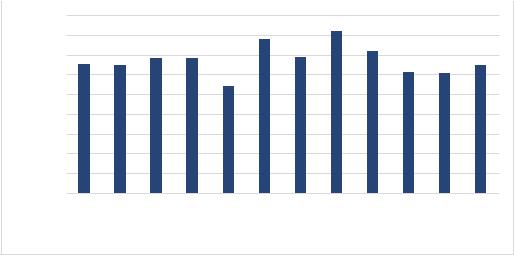
2.4. Disscussion
The Apatity city is relatively young, much younger than the now smaller Kirovskis, and initially it was not planned to be as large as Kirovsk. This is evidenced by the differences in the centers of these cities. In Kirov is dominated by monumental socialist realism, as in Murmansk and several other towns in Kola. There is also an impressive (now burned) train station, much larger than the Apatite. However, perhaps due to slightly better climatic conditions and practical reasons (better connection near the important railway line), Apatity are now a much larger and more developed city than Kirovsk. In Accomplishments, strict development is present along Lenin Street, Central Square and Fersman Street. Buildings, though not as impressive as in Kirovsk, are built more later in a more modernist style. They are also surrounded by ordinary blocks built of brick or slabs. Next to them are new buildings (such as the Amusement Park, adapted from an earlier unfinished complex), but even today there are many abandoned investments in the city. Field studies have shown that in outer housing blocks, the outer walls are usually covered with gray plaster, sometimes with a mosaic or pigment admixture. At present, their condition is different, however, due to the acute northern climate. Analyzes in the microbehave allowed to show such dopants as sulfur chlorine, phosphorus, and iron, titanium, zinc and lead. Zinc was found in samples 02, 03, 05–07 and 11 (Fersman Street, Lenin, Severnaya) and lead in 06 and 09 (Lenin and Kozlov). These are areas of busy traffic. Several plants have also been found as an example of their secondary processes of corrosion and the entry of flora into places of dampness. Tests of aggregate metal content found by ICP-OAS in apatite plaster samples showed some homogeneity. All of them had a total amount of pollutants above 10,000 ppm. The highest concentrations of metals were found in samples 06, 08 and 07 and 09 up to 15 thousand. Ppm (Fersman and Kozlov Street). Lowest in sample 5-not above 10ty ppm (fig. 2.4) from the perimeter of the city ul. Pobiedy practically in contact with the scrubs.
18000,00
16000,00
14000,00
12000,00
10000,00
8000,00
6000,00
4000,00
2000,00
0,00
Ap01 Ap02 Ap03 Ap04 Ap05 Ap06 Ap07 Ap08 Ap09 Ap10 Ap11 Ap12
 Suma
Suma
Fig. 2.4. Summaric countents of the metals in samples from Apatity
51
The highest pollution is mainly connected to streets such as Fersman, Lenin – the main arteries of the city and ul. Kozlov, where transit transport to Kirovskaya takes place. Some of the pollution has also been found at Stroiteley Street, but it is close to a complex of garages, certain facilities and a railway line. Perhaps some of these pollutants come from cars and railroads. There are no trolleybuses and other large establishments in the Apatity that are located mainly north of the city (Anof). This is where there are processing plants of ore mined in Khibina.
2.5. Conclusion
The city of apathy is relatively young, and has numerous blocks. There are only a few representative buildings in the city, mainly belonging to the city authorities and the Russian Academy of Sciences. The condition of these buildings is well maintained and there are numerous signs of corrosion due to the difficult wet climate conducive to physical weathering through freezing. Due to the city’s character, plastered pigments do not show great variation. Tested samples from Apatity show moderate contamination with heavy metals. These results are confirmed by both microarray research and ICP-OAS chemical analyzes. Their source is primarily traffic in the city and transit traffic to Kirovsk.
2.6. References
1.Adamson, S., Bates, R., Laslett, R., Pototschnig, A.; 1996, Energy use, air pollution, and environmental policy in Krakow. Can economic incentives really help? World Bank Technical Paper no. 308. The World Bank, Washington D.C.
2.Andrzejewski R.; 1975, Problemy ekologiczne kształtowania środowiska w mieście. Wiad. Ekol. 21: 175–186.
3.Beck B. D. and Brain J. D.; 1982, Prediction of the pulmonary toxicity of respirable combustion products from residential wood and coal stoves. In Residential Wood and Coal Combustion, pp. 264-280. Air Pollution Control Association, Louisville, Kentucky. Dockery D. W., Pope C. A. III, Xu X.
4.Berkowicz, R.; 1998, Street scale models. In: Fenger, J., Hertel, O., Palmgren, F. (Eds.), Urban Air Pollution, European Aspects. Kluwer Academic Publishers, Dordrecht, pp. 223–251.
5.Bogdanowski J. (red); 2001, Krajobraz kulturowy Polski. Województwo Małopolskie, red. Stowarzyszenie Kultura i Natura, Kraków-Warszawa.
6.Carmichael, G.R., Ferm, M., Adikary, S., Ahmad, J., Mohan, M., Hong, M.S., Chen, L., Fook, L., Liu, C.M., Soedomo, M., Tran, G., Suksomsank, K., Zhao, D., Arndt, R., Chen, L.L.; 1995, Observed regional distribution of sulfur dioxide in Asia. Water, Air and Soil Pollution 85, 2289–2294.
7.Cela A., Lankford L., Knowles-Lankford J.; 2009, Visitor Spending and Economic Impacts of Heritage Tourism: A Case Study of the Silos and Smokestacks National Heritage Area, Journal of Heritage Tourism, nr 3.
52
8.Cheng, Y., Lee, S.C., Ho, K.F., Wang, Y.Q., Cao, J.J., Chow, J.C., Watson, J.G.; 2006, Black carbon measurement in a coastal area of south China. Journal of Geophysics Research.
9.Dettloff P.; 2006, Odbudowa i restauracja zabytków architektury w Polsce w latach 1918-1939: teoria i praktyka, Universitas, Kraków.
10.Dębski J.;2002, Lokalne bieguny wzrostu w Polsce na przełomie XX i XXI wieku. Tom II, Wyższa Szkoła Finansów i Zarządzania w Białymstoku, Białystok.
11.Dod, R.L., Giauque, R.D., Novakov, T.; 1986, Sulfate and carbonaceous aerosols in Beijing, China. Atmospheric Environment 20, 2271–2275.
12.Dominici F., McDermott A., Daniels M., Zeger S.L., Samet J.N; 2005, Revised Analyses of the National Morbidity, Mortality, and Air Pollution Study: Mortaity Among Residents Of 90 Cities, Journal of Toxicology and Environmental Health, Part A, 68:13–14, 1071–1092, DOI: 10.1080/15287390590935932.
13.Huber M.; 2014, Study of precipitates in the petroarchitecture detail samples from Bern-Switzerland. JBES, 4(S1):29.
14.Fundacja Partnerstwo dla Środowiska; 2008, Wkład firm społecznych w rewitalizacją dziedzictwa przyrodniczego i kulturowego, Studia przypadków z Polski, Francji, Włoch i Finlandii, red. N. Gałuszka, R. Serafin, Kraków.
15.Grønskei, K.E.; 1998, Europe and its Cities. In: Fenger, J., Hertel, O., Palmgren,
F.(Eds.), Urban Air Pollution, European Aspects. Kluwer Academic Publishers, Dordrecht, pp. 21–32.
16.GUS: Baza noclegowa i jej wykorzystanie w 2009 roku. 23.04.2010. [dostęp
2011-03-05].
17.Hawksworth D.L., Dudek K.; 1981, Epiphytic lichenes of Skawina (southern Poland) Zesz. Nauk UJ, Pr. Bot. 8: 173–189.
18.Majewski P; 2009, Ideologia i konserwacja. Architektura zabytkowa w Polsce w czasach socrealizmu, Trio, Warszawa.
19.Małopolski Regionalny Program Operacyjny na lata 2007-2013, Załącznik nr 1 do Uchwały nr 780/07 Zarządu Województwa Małopolskiego z dnia 4 października 2007 r. w sprawie przyjęcia Małopolskiego Regionalnego Programu Operacyjnego na lata 2007-2013, Kraków 2007.
20.Mukai, H., et al.; 2001, Regional characteristics of sulfur and lead isotope ratios in the atmosphere at several Chinese urban sites. Environmental Science & Technology 35, 1064–1071.
21.Murzyn M.; 2006, Kazimierz. Środkowoeuropejskie doświadczenie rewitalizacji, MCK, Kraków.
22.Murzyn M.; 2008, Heritage Transformation in Central and Eastern Europe [w:] The Ashgate Research Companion to Heritage and Identity, red. B. Graham,
P.Howard, Ashgate, Aldershot.
23.Murzyn-Kupisz M.; 2010, Dziedzictwo kulturowe Nowej Huty. Szansa czy balast dla dzielnicy? [w:] Dziedzictwo kulturowe wielkich miast polskich a transformacja: pole konfliktu czy czynnik rozwoju? Uniwersytet Ekonomiczny w
Krakowie, Kraków 2010, maszynopis.
24.OECD, 1995a. Motor vehicle pollution. Reduction strategies beyond 2010. Organisation for Economic Co-operation and Development, Paris.
53
25.Purchla J., Broński K., Murzyn – Kupisz M., Smoleń M.; Przemysł kulturowy. Województwo małopolskie, Kraków.
26.Riegl A.; 2002, Nowoczesny kult zabytków. Jego istota i powstanie [w:] Alois Riegl, Georg Dehio i kult zabytków, red. J. Krawczyk, Mówią Wieki, Warszawa.
27.Samet, J. M., Dominici, F., Curriero, F. C., Coursac, I., and Zeger, S. L.; 2000, Fine particulate air pollution and mortality in 20 US cities, 1987–1994. N. Engl. J. Med. 343:1742–1749.
28.Shi, Z., Shao, L., Jones, T.P., Lu, S.; 2005, Microscopy and mineralogy of airborne particles collected during severe dust storm episodes in Beijing, China. Journal of Geophysical Research 110, D01303.
29.Zaręba D. (red.); 2008, Ekoturystyka i odkrywanie dziedzictwa. Zbiór dobrych praktyk, Fundacja Partnerstwo dla Środowiska, Kraków 2008.
30.Апатиты. Города России: энциклопедия. М.: Большая Российская энциклопедия, 1994. С. 22. 559 с.
31.Харитонов С. Ф., Звягин Ю. И. Мурманская. Кировская. Октябрьская, Петрозаводск. 1996.
32.Ферсман А. Е. Путешествия за камнем. М.: Изд-во АH СССР, 1960.
33.Боруцкий Б. Е. Современные представления о природе и геологической истории формирования пород Хибинского щелочного массива (Критическое
сопоставление предлагавшихся гипотез и комментарии к ним) / Ред. Ю.Л. Войтеховский. Уникальные геологические объекты Кольского полуострова: Хибины. Апатиты: К & М, 2010. С. 7–30.
34.Словарь современных географических названий. Екатеринбург: У-Фактория. Под общей редакцией акад. В. М. Котлякова. 2006.
35.Г.К Тушинский. Ледники, снежники, лавины Советского Союза. М.:
Географгиз, 1963. С. 226. 310 с.
36.Народное хозяйство СССР за 70 лет. Юбилейный статистический ежегодник. Финансы и статистика, Москва, 1987 год.
37.Мурманская область. Оценка численности постоянного населения на 1 января
2009–2015 гг., http://www.gks.ru/dbscripts/munst/munst47/DBInet.cgi?pl= 8112027.
54
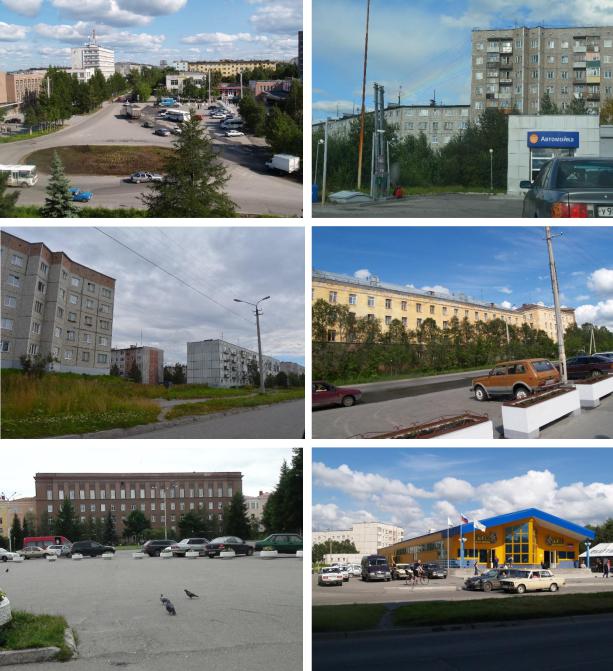
2.7. Graphic and tables attachement
Fig. 2.5. Photographs of the building type in Apatity
55

Ap01
Ap02
Ap03
Ap04
Ap05
56
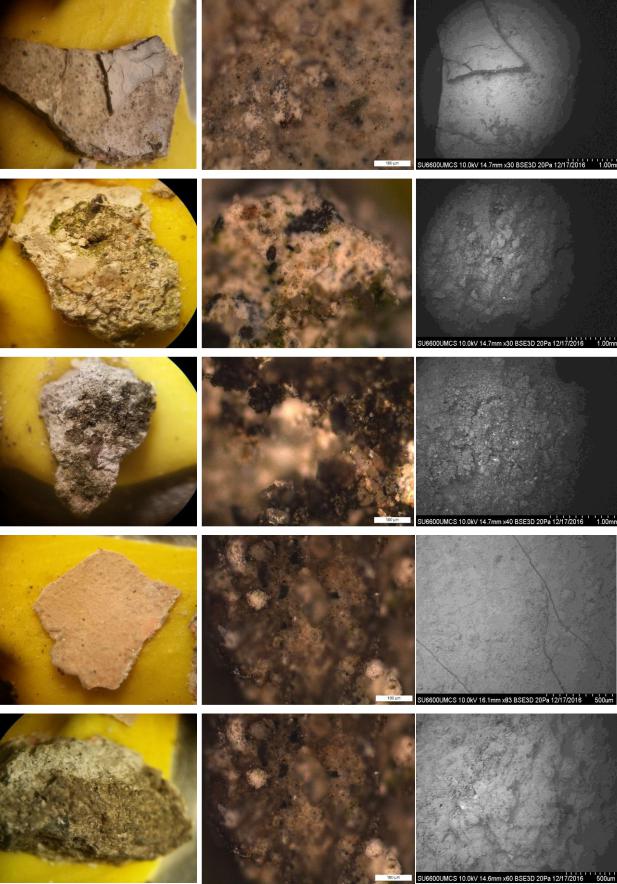
Ap06
Ap07
Ap08
Ap09
Ap10
57
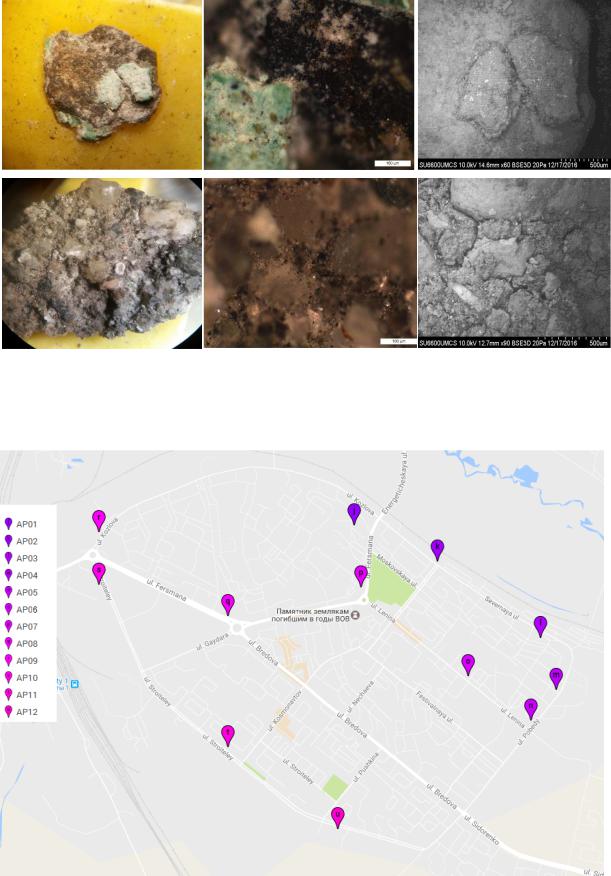
Ap11
Ap12
Fig. 2.6. Microphotographs from the binocular magnifier (left),
polarized microscope in reflected light (center) and electrons backwards scattered (right) Apatity plaster samples
Fig. 2.7. Situated sketch of the Apatity city with markered sample localization
58
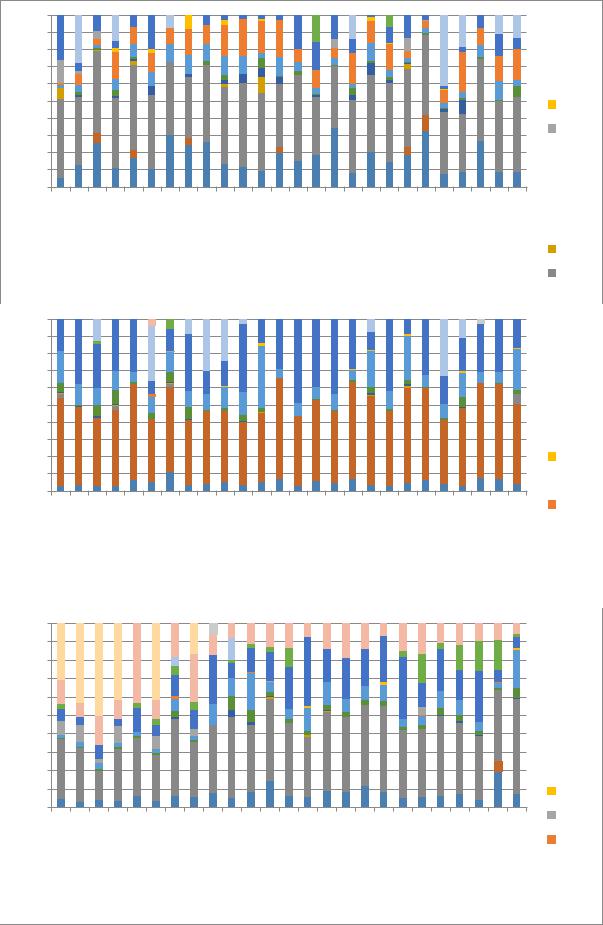
100%
90%
80%
70%
60%
50%
40%
30%
20%
10%
0%
Ap01Tynk(1) pt1 |
Ap01Tynk(1) pt2 |
Ap01Tynk(1) pt3 |
Ap01Tynk(1) pt4 |
Ap01Tynk(1) pt5 |
Ap01Tynk(1) pt6 |
Ap01Tynk(1) pt7 |
Ap01Tynk(1) pt8 |
Ap01Tynk(1) pt9 |
Ap01Tynk(1) pt10 |
Ap01Tynk(1) pt11 |
Ap01Tynk(1) pt12 |
Ap01Tynk(1) pt13 |
Ap01Tynk(1) pt14 |
Ap01Tynk(1) pt15 |
Ap01Tynk(1) pt16 |
Ap01Tynk(1) pt17 |
Ap01Tynk(1) pt18 |
Ap01Tynk(1) pt19 |
Ap01Tynk(1) pt20 |
Ap01Tynk(1) pt21 |
Ap01Tynk(1) pt22 |
Ap01Tynk(1) pt23 |
Ap01Tynk(1) pt24 |
Ap01Tynk(1) pt25 |
Ap01Tynk(1) pt26 |
100%
90%
80%
70%
60%
50%
40%
30%
20%
10%
0%
Ap02Tynk(1) pt1 |
Ap02Tynk(1) pt2 |
Ap02Tynk(1) pt3 |
Ap02Tynk(1) pt4 |
Ap02Tynk(1) pt5 |
Ap02Tynk(1) pt6 |
Ap02Tynk(1) pt7 |
Ap02Tynk(1) pt8 |
Ap02Tynk(1) pt9 |
Ap02Tynk(1) pt10 |
Ap02Tynk(1) pt11 |
Ap02Tynk(1) pt12 |
Ap02Tynk(1) pt13 |
Ap02Tynk(1) pt14 |
Ap02Tynk(1) pt15 |
Ap02Tynk(1) pt16 |
Ap02Tynk(1) pt17 |
Ap02Tynk(1) pt18 |
Ap02Tynk(1) pt19 |
Ap02Tynk(1) pt20 |
Ap02Tynk(1) pt21 |
Ap02Tynk(1) pt22 |
Ap02Tynk(1) pt23 |
Ap02Tynk(1) pt24 |
Ap02Tynk(1) pt25 |
Ap02Tynk(1) pt26 |
100%
90%
80%
70%
60%
50%
40%
30%
20%
10%
0%
Ap03Tynk(1) pt1 |
Ap03Tynk(1) pt2 |
Ap03Tynk(1) pt3 |
Ap03Tynk(1) pt4 |
Ap03Tynk(1) pt5 |
Ap03Tynk(1) pt6 |
Ap03Tynk(1) pt7 |
Ap03Tynk(1) pt8 |
Ap03Tynk(1) pt9 |
Ap03Tynk(1) pt10 |
Ap03Tynk(1) pt11 |
Ap03Tynk(1) pt12 |
Ap03Tynk(1) pt13 |
Ap03Tynk(1) pt14 |
Ap03Tynk(1) pt15 |
Ap03Tynk(1) pt16 |
Ap03Tynk(1) pt17 |
Ap03Tynk(1) pt18 |
Ap03Tynk(1) pt19 |
Ap03Tynk(1) pt20 |
Ap03Tynk(1) pt21 |
Ap03Tynk(1) pt22 |
Ap03Tynk(1) pt23 |
Ap03Tynk(1) pt24 |
Ap03Tynk(1) pt25 |
 Fe-L
Fe-L
 Ti-K
Ti-K
 Ca-K
Ca-K
K-K
P-K
 Si-K
Si-K
 Al-K
Al-K
 Mg-K
Mg-K
 Na-K
Na-K
F-K
O-K
 Br-L
Br-L
 Zn-L
Zn-L
 Fe-L
Fe-L
 Ti-K
Ti-K
 Ca-K
Ca-K
K-K
 Cl-K
Cl-K
P-K
 Si-K
Si-K
 Al-K
Al-K
 Mg-K
Mg-K
 Ba-L
Ba-L
 Br-L
Br-L
 Zn-L
Zn-L
 Fe-L
Fe-L
 Ti-K
Ti-K
 Ca-K
Ca-K
K-K
S-K
P-K
 Si-K
Si-K
 Al-K
Al-K
59

100% |
|
|
|
|
|
|
|
|
|
|
|
|
|
|
|
|
|
|
|
|
|
|
|
|
|
|
90% |
|
|
|
|
|
|
|
|
|
|
|
|
|
|
|
|
|
|
|
|
|
|
|
|
Br-L |
|
80% |
|
|
|
|
|
|
|
|
|
|
|
|
|
|
|
|
|
|
|
|
|
|
|
|
||
|
|
|
|
|
|
|
|
|
|
|
|
|
|
|
|
|
|
|
|
|
|
|
|
|
||
70% |
|
|
|
|
|
|
|
|
|
|
|
|
|
|
|
|
|
|
|
|
|
|
|
|
Fe-L |
|
60% |
|
|
|
|
|
|
|
|
|
|
|
|
|
|
|
|
|
|
|
|
|
|
|
|
Ca-K |
|
50% |
|
|
|
|
|
|
|
|
|
|
|
|
|
|
|
|
|
|
|
|
|
|
|
|
||
|
|
|
|
|
|
|
|
|
|
|
|
|
|
|
|
|
|
|
|
|
|
|
|
|
||
40% |
|
|
|
|
|
|
|
|
|
|
|
|
|
|
|
|
|
|
|
|
|
|
|
|
K-K |
|
30% |
|
|
|
|
|
|
|
|
|
|
|
|
|
|
|
|
|
|
|
|
|
|
|
|
Si-K |
|
20% |
|
|
|
|
|
|
|
|
|
|
|
|
|
|
|
|
|
|
|
|
|
|
|
|
||
|
|
|
|
|
|
|
|
|
|
|
|
|
|
|
|
|
|
|
|
|
|
|
|
|
||
10% |
|
|
|
|
|
|
|
|
|
|
|
|
|
|
|
|
|
|
|
|
|
|
|
|
Al-K |
|
0% |
|
|
|
|
|
|
Ap05Tynk(1) pt8 |
|
Ap05Tynk(1) pt10 |
Ap05Tynk(1) pt11 |
Ap05Tynk(1) pt12 |
Ap05Tynk(1) pt13 |
Ap05Tynk(1) pt14 |
Ap05Tynk(1) pt15 |
Ap05Tynk(1) pt16 |
Ap05Tynk(1) pt17 |
Ap05Tynk(1) pt18 |
Ap05Tynk(1) pt19 |
Ap05Tynk(1) pt20 |
Ap05Tynk(1) pt21 |
Ap05Tynk(1) pt22 |
Ap05Tynk(1) pt23 |
Ap05Tynk(1) pt24 |
Ap05Tynk(1) pt25 |
Mg-K |
|
Ap05Tynk(1) pt1 |
Ap05Tynk(1) pt2 |
Ap05Tynk(1) pt3 |
Ap05Tynk(1) pt4 |
Ap05Tynk(1) pt5 |
Ap05Tynk(1) pt6 |
Ap05Tynk(1) pt7 |
Ap05Tynk(1) pt9 |
|||||||||||||||||||
Na-K |
||||||||||||||||||||||||||
F-K |
||||||||||||||||||||||||||
O-K |
||||||||||||||||||||||||||
|
||||||||||||||||||||||||||
100% |
|
|
|
|
|
|
|
|
|
|
|
|
|
|
|
|
|
|
|
|
|
|
|
|
|
|
90% |
|
|
|
|
|
|
|
|
|
|
|
|
|
|
|
|
|
|
|
|
|
|
|
|
Br-L |
|
|
|
|
|
|
|
|
|
|
|
|
|
|
|
|
|
|
|
|
|
|
|
|
|
|
||
80% |
|
|
|
|
|
|
|
|
|
|
|
|
|
|
|
|
|
|
|
|
|
|
|
|
Zn-L |
|
70% |
|
|
|
|
|
|
|
|
|
|
|
|
|
|
|
|
|
|
|
|
|
|
|
|
Fe-L |
|
|
|
|
|
|
|
|
|
|
|
|
|
|
|
|
|
|
|
|
|
|
|
|
|
|
||
60% |
|
|
|
|
|
|
|
|
|
|
|
|
|
|
|
|
|
|
|
|
|
|
|
|
Ti-K |
|
50% |
|
|
|
|
|
|
|
|
|
|
|
|
|
|
|
|
|
|
|
|
|
|
|
|
||
|
|
|
|
|
|
|
|
|
|
|
|
|
|
|
|
|
|
|
|
|
|
|
|
|
||
40% |
|
|
|
|
|
|
|
|
|
|
|
|
|
|
|
|
|
|
|
|
|
|
|
|
Ca-K |
|
|
|
|
|
|
|
|
|
|
|
|
|
|
|
|
|
|
|
|
|
|
|
|
|
|
||
30% |
|
|
|
|
|
|
|
|
|
|
|
|
|
|
|
|
|
|
|
|
|
|
|
|
K-K |
|
20% |
|
|
|
|
|
|
|
|
|
|
|
|
|
|
|
|
|
|
|
|
|
|
|
|
P-K |
|
10% |
|
|
|
|
|
|
|
|
|
|
|
|
|
|
|
|
|
|
|
|
|
|
|
|
||
|
|
|
|
|
|
|
|
|
|
|
|
|
|
|
|
|
|
|
|
|
|
|
|
Si-K |
||
0% |
|
|
|
|
|
|
|
|
|
|
|
|
|
|
|
|
|
|
|
|
|
|
|
|
||
|
|
|
|
|
|
Ap04Tynk(1) pt8 |
|
|
|
|
|
|
|
|
|
Ap04Tynk(1) pt18 |
|
|
|
|
|
|
|
|
||
Ap04Tynk(1) pt1 |
Ap04Tynk(1) pt2 |
Ap04Tynk(1) pt3 |
Ap04Tynk(1) pt4 |
Ap04Tynk(1) pt5 |
Ap04Tynk(1) pt6 |
Ap04Tynk(1) pt7 |
Ap04Tynk(1) pt9 |
Ap04Tynk(1) pt10 |
Ap04Tynk(1) pt11 |
Ap04Tynk(1) pt12 |
Ap04Tynk(1) pt13 |
Ap04Tynk(1) pt14 |
Ap04Tynk(1) pt15 |
Ap04Tynk(1) pt16 |
Ap04Tynk(1) pt17 |
Ap04Tynk(1) pt19 |
Ap04Tynk(1) pt20 |
Ap04Tynk(1) pt21 |
Ap04Tynk(1) pt22 |
Ap04Tynk(1) pt23 |
Ap04Tynk(1) pt24 |
Ap04Tynk(1) pt25 |
Al-K |
|||
Mg-K |
||||||||||||||||||||||||||
Na-K |
||||||||||||||||||||||||||
F-K |
||||||||||||||||||||||||||
|
||||||||||||||||||||||||||
100% |
|
|
|
|
|
|
|
|
|
|
|
|
|
|
|
|
|
|
|
|
|
|
|
|
|
|
90% |
|
|
|
|
|
|
|
|
|
|
|
|
|
|
|
|
|
|
|
|
|
|
|
|
Ba-L |
|
80% |
|
|
|
|
|
|
|
|
|
|
|
|
|
|
|
|
|
|
|
|
|
|
|
|
Pb-M |
|
|
|
|
|
|
|
|
|
|
|
|
|
|
|
|
|
|
|
|
|
|
|
|
|
|
||
70% |
|
|
|
|
|
|
|
|
|
|
|
|
|
|
|
|
|
|
|
|
|
|
|
|
W-M |
|
60% |
|
|
|
|
|
|
|
|
|
|
|
|
|
|
|
|
|
|
|
|
|
|
|
|
||
|
|
|
|
|
|
|
|
|
|
|
|
|
|
|
|
|
|
|
|
|
|
|
|
|
||
50% |
|
|
|
|
|
|
|
|
|
|
|
|
|
|
|
|
|
|
|
|
|
|
|
|
Br-L |
|
|
|
|
|
|
|
|
|
|
|
|
|
|
|
|
|
|
|
|
|
|
|
|
|
|
||
40% |
|
|
|
|
|
|
|
|
|
|
|
|
|
|
|
|
|
|
|
|
|
|
|
|
Zn-L |
|
30% |
|
|
|
|
|
|
|
|
|
|
|
|
|
|
|
|
|
|
|
|
|
|
|
|
Fe-L |
|
|
|
|
|
|
|
|
|
|
|
|
|
|
|
|
|
|
|
|
|
|
|
|
|
|
||
20% |
|
|
|
|
|
|
|
|
|
|
|
|
|
|
|
|
|
|
|
|
|
|
|
|
Ti-K |
|
10% |
|
|
|
|
|
|
|
|
|
|
|
|
|
|
|
|
|
|
|
|
|
|
|
|
||
|
|
|
|
|
|
|
|
|
|
|
|
|
|
|
|
|
|
|
|
|
|
|
|
|
||
0% |
|
|
|
|
|
|
|
|
|
|
|
|
|
|
|
|
|
|
|
|
|
|
|
|
Ca-K |
|
|
|
|
|
|
|
|
|
|
|
|
|
|
|
|
|
|
|
|
|
|
|
|
|
|
||
|
|
|
|
|
|
|
|
|
|
|
|
|
|
|
|
|
|
|
|
|
|
|
|
|
K-K |
|
|
|
|
|
|
|
|
|
|
|
|
|
|
|
|
|
|
|
|
|
|
|
|
|
|
S-K |
|
|
|
|
|
|
|
|
|
|
|
|
|
|
|
|
|
|
|
|
|
|
|
|
|
|
Si-K |
|
|
|
|
|
|
|
|
|
|
|
|
|
60 |
|
|
|
|
|
|
|
|
|
|
|
|
||
